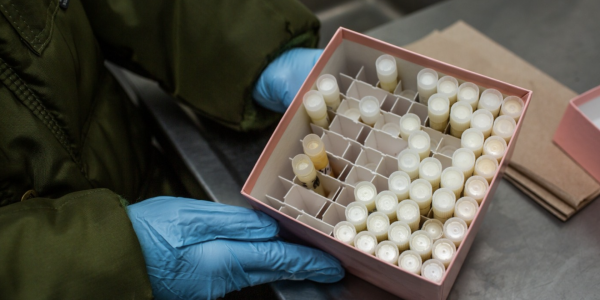A new Leakey Foundation award will support research to better understand how certain hormones in breast milk contribute to brain growth in humans and primates.
E.A. Quinn, associate professor of biological anthropology, has received a grant from the Leakey Foundation to study how neurotropic hormones in human and primate milk affect brain growth.

Humans have very large brains at birth and experience rapid periods of brain growth during infancy. Primates also experience accelerated brain development early in life compared to other mammals.
Quinn’s project will use existing samples of primate milk to look for neurotropic hormones and nutrients and, once detected, determine if there’s any correlation between species’ rates of brain development and the concentration of the hormones in their milk. The project will conduct the same inquiries on samples from human milk, comparing the two.
The team anticipates humans will exhibit the highest amounts of these hormones, followed by apes, monkeys, and prosimians. “Within species, we would expect to see a correlation between how rapidly infants’ brains developed and the change in size from birth to weaning, with species that had higher rates of brain growth having more of these hormones,” Quinn said.
The primate milk samples will come from Quinn’s collaborator Michael Power, who curates the milk repository at the Smithsonian’s National Zoo and Conservation Biology Institute, a collection with samples from more than 200 species. The human samples will come from Quinn’s earlier work in the field, including the United States, the Philippines, and Nepal, where Quinn worked for four years on the Infancy at Altitude and Milk at Altitude projects.

Though much of Quinn’s career has been centered around field research, she runs a fully equipped Biosafety Level 2 wet lab in McMillan Hall, where Quinn and her team will analyze the primate and human samples in the coming semester. The lab will look for BDNA (brain-derived neurotrophic factor), NGF (nerve growth factor), and GDNF (glial cell line-derived factor) in the samples.
This study will build on a driving question of Quinn’s career: “I want to understand why and how human infants have evolved these large brains, these high levels of body fat, and how human milk is a part of that story,” she said. By comparing human and primate milk samples, she hopes to better understand the unique and essential function of breast milk.
Quinn’s questions have many applications outside the lab, too. She is currently collaborating with Brown School professor Lora Iannotti on a project based in rural Ecuador. Funded by the Arts & Sciences SPEED (Seeding Projects for Enabling Excellence & Distinction) grant initiative, the project will study human infant brain development and its relationship to milk composition, with particular attention to the use of whole foods. Similar to Quinn’s comparative study, their research will analyze milk composition — specifically neurotrophic factors and nutrients — and brain development using infant brain imaging. The project builds on Iannotti’s nutritional intervention research program in Ecuador.
(Header Photo: Courtesy of The Smithsonian National Zoo and Conservation Biology Institute)




